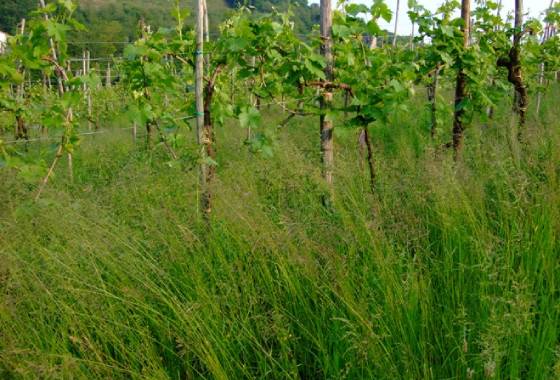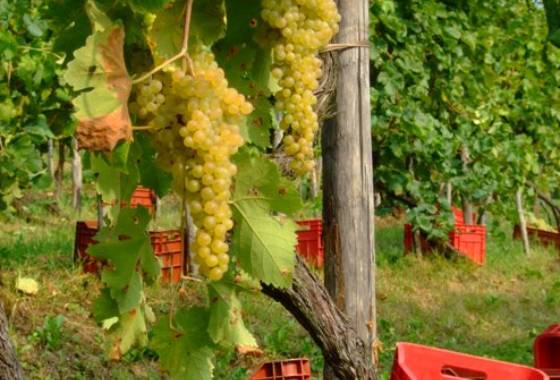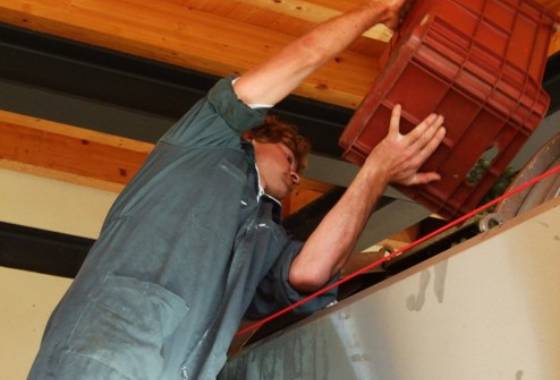Work in the Vineyard and the Winery
The steps leading to the production of a wine are simple but well defined and they start from the ground. A terrain is made up of rock (minerals) and soil (microbes and organic substance): two different but equally important components. The vine probes the ground and absorbs the minerals in it thanks to the fungi and bacteria which live in the soil. So that the vine can absorb the minerals in the ground through its roots, the soil must be alive and not made sterile by the application of weed killers, chemical fertilisers and massive use of pesticides and fungicides. The vitality and fertility of the soil must remain high to guarantee that intimate relationship between plant and ground.
That is why I decided not to use weed killers or chemical fertilisers but chose copper and sulphur to control powdery and downy mildew. In line with biodynamic farming practice, I spread horn manure with compost preparations (500P) over the ground in autumn and spring to increase microbial life in the soil and stimulate root development and penetration into the ground. We don’t use fertilisers, we don’t weed and we let the grass grow naturally. When the plant is pruned in winter it should not be left overloaded with buds. I have no fixed rule on the number of buds, but decide how many to leave on the basis of each plant’s vigour. These are normally 10 on the youngest Guyot-trained vines to about 20 on the oldest trained with double canopy. I promptly remove all double buds in spring so that the leaves are better ventilated. New growth is tied regularly to the supports. I do a single topping by hand in the summer, deciding on the amount to cut off according to shoot growth.
I harvest when the grape is sweet but still crunchy. Not too ripe because I want to maintain what is for me the important and correct amount of acidity. When harvesting, we place the grapes in crates to preserve their integrity. They are pressed in bunches, without removing the stalks, to extract the best juice in each individual grape as gently as possible. After cold static decantation, the must ferments spontaneously in cement tanks, where the temperature is controlled to ensure it does not exceed 22°C It is really essential to let every tank proceed with its fermentation process without any help from activators and exogenous yeasts. By doing this various micro-organisms can work in the must: first those from the grape itself followed by those of the winery. Only in this way can we guarantee the formation of genuine aromas and flavours tied to the soil and the vine. I like to call this the actual “wine-making” stage – the most important. It would be truly difficult if not actually impossible to obtain a territorial wine without letting spontaneous fermentation occur. This first and highly important fermentation process will have a strong effect even on a semi-sparkling or sparkling wine which undergoes secondary fermentation. Removing material from the must with excessive decantation, altering its nutritional values and in particular inoculating it with a population of exogenous yeast makes the resulting wine poorer, unrefined, banal and with no territorial characteristics.
When fermentation is complete, the wine is racked off to remove the gross lees and a small amount of sulphur dioxide is added immediately after that. It is then left to rest throughout the winter in cement tanks. In order to give my wine its territorial characteristics I consider it equally important to leave it to age on the fine lees for six months until spring. It is during this period that the wine becomes well balanced helped by the yeast. The wine would be impoverished if it were to be clarified or filtered as soon as fermentation stops.
In March, the wine undergoes light clarification if needed and we add the right amount of sugar to obtain the required pressure in the bottle (18 g/l to develop 4.5 bar). A selected yeast is then added and secondary fermentation takes place in pressurized steel tanks called autoclaves, where the temperature is controlled. At the end of fermentation, the wine is microfiltered and then bottled with a final dose of SO2. Secondary fermentation brings out the character of this wine, whose lightness, rather than its intensity, is what makes it so outstanding.
The wine is an ‘extra brut’ with no residual sugar, a decision we intentionally made to enhance the original flavour and achieve a natural balance between acidity, sapidity and structure. Our wine is not the result of a single ‘cru’ but of all our vineyards, where the individual qualities of each vine blend to produce greater complexity of character.
I do not consider myself a fanatical naturalist who leaves everything completely to nature or to chance. I just wish to guide the natural process, interfering as little as possible and only when I deem it necessary to ensure that the clarity, fineness, pleasurable nature and flavour of the wine are maintained without altering its natural balance. I try to convey the fine and sophisticated character of the very best Prosecco from Valdobbiadene in my wines.



